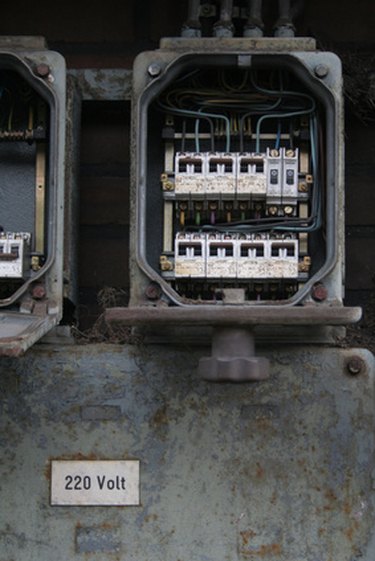Things You'll Need
Amp ratings of all devices on circuit
Clamp on AC ammeter with peak hold
Extra fuses

A circuit breaker will trip when the total current draw exceeds the breaker's capacity. The current surge when a motor starts can trip the breaker. Shorts, ground faults, rusty connections and extension cords can also cause breakers to trip.
Check Circuit Ampacity and Draw
Step 1
Check the amperage rating of the appliance by looking in the manual or on the motor or specifications plate. There may be separate ratings for other electrical components (fans or blowers, for instance). Add all these together. If the total amperage of the unit is greater than the rating of the circuit breaker, then it needs to be placed on a higher ampacity circuit. Add the amperage of any other appliances on the circuit. If that total exceeds the breaker's rating, take some things off the circuit.
Video of the Day
Step 2
Check for ground faults. If you need to press a button on the outlet, there is a ground fault. If the motor is using a two-prong plug in a three-prong outlet (or uses an adapter), the malfunctioning device may not be sufficiently grounded. If the circuit is old, it may not have a ground even if the outlet has three prongs.
Step 3
Eliminate extension cords .If the unit is plugged in to an extension cord, plug it directly into an outlet and try it again.
Step 4
Determine peak amperage and actual running amperage. Turn off all other appliances on the circuit. Clamp the ammeter around the wire leading out of the fuse box feeding the circuit and place it in peak hold mode. Turn on the motor. Record the peak amperage. If the breaker trips when the motor starts, the peak draw is the problem. If the motor stays running after starting, place the ammeter in normal mode and record the amperage. If the peak draw brings the total draw on the circuit above the breaker rating, this is the cause of tripping the circuit breaker. If the actual operating amperage is greater than the device rating, there is problem in the unit. If the current draw is normal, try replacing the circuit breaker.
Step 5
Troubleshoot the appliance.Turn the shaft by hand if it is accessible to see if the motor is frozen. Perform recommended lubrication and cleaning. Replace worn belts and tighten if needed. The owner's manual should describe the amount of deflection recommended in a belt. Insure all pulleys and tensioners rotate freely. Check for shorts, frayed wiring insulatio, and loose or rusty connections. Sand rust to bare metal on grounds to housings. Replace rusty connectors. Charred or blackened wires or connectors indicate high current draw by the connected subassembly. Repair the subassembly and replace affected wiring. This may be best left to a professional.
Warning
Always unplug the unit or turn off the circuit breaker before performing maintenance or removing housings. Operating a poorly insulated appliance on an ungrounded circuit can lead to electrocution.
Video of the Day